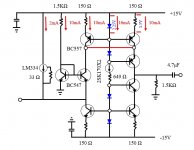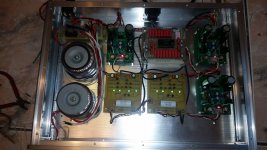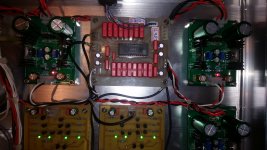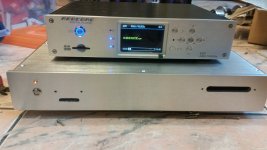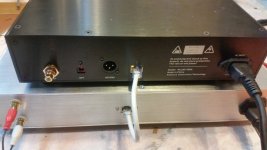Okay ... got it to work! Not sure what the issue was, but the ckt. I veroboarded years ago (2009) worked pretty much upon installation in my Philips CD-60.
Nice improvement (!!) over prev. opa2132 (which was heavily tweaked in and of itself).
Hmmm ... there's further potential with better transistors and other stuff noted in this thread. But maybe RB's v2 would be a better/"funner" upgrade!
Nice improvement (!!) over prev. opa2132 (which was heavily tweaked in and of itself).
Hmmm ... there's further potential with better transistors and other stuff noted in this thread. But maybe RB's v2 would be a better/"funner" upgrade!
I do have some SA970's and SC2240's to try, which might sound better...but even with generic parts it sounds pretty good.
Gave it another go with Rbrorer's original ckt. This time using Toshiba trans. he discussed in OP.
No, go. Same issues I ran into with Jocko's joke: the "Easy-to-Build" I/V.
Back to the BC547/557 .... this time, I did opt for red LED, instead of green (my prev. build). I think the reds sound better.
BTW: one part of the ckt I did not add were the 1000uF caps on both rails. Not sure why these deemed necessary ... tho' I beg to educated differently.
I have some Zetex trans. 651 and 751 in my bin. They're supposed to be a step up from BC544/BC557. Might try these ... but the Toshiba substitution was a total time waster!!
Hollowman,
With the greatest respect, the schematic shown in post #100 is not the simple i/v version one posted by Rudolf ("1st version").
I have successfully built on veroboard the 1st version, several versions with different transistors and different coloured led's and they have all worked beautifully from first power up.
I have used BC550, BC560 as well as the ones indicated in the schematic i.e. BC547, BC557, as well as 2SC2240, 2SA970 and even one that I currently have installed in a PCM63 Dac is built with BD437 and BD438, with no changes to the circuit as shown in the schematic at Post #1.
I still regularly use the PCM63 dac.
I recall from memory that the one that I built with 2SC2240 and 2SA970 seemed more transparent and clearer in comparison with the BC547, BC557 versions, although I admit that I have not heard the i/v for several years as I took it out and installed it in a friend's cd player.
In all versions that I built, I used Solens 2.2uF polypropylene caps at the output.
The version I built with BD437 and BD438 was because I had read somewhere, I think in posts concerning the Hart Kit of the Linsley Hood phono preamp that medium power transistors such as BD437 and BD438 were chosen by HART for the input transistors in the Linsley Hood design because they were quieter than the BC560, BC550 complementary transistors.
My experience is that the BD437 and BD438 seemed more expansive and gives a wider soundstage., much like the difference between the sound of an identical circuit but built using 6SN7 as compared with 6CG7 or 12 AU7 tubes, although the 6CG7 is said to be electrically identical to the 6SN7.
Of course these observations as to the sound are my subjective impressions. But in all fairness to rbroer, it has to be said and acknowledged that the circuit in post #1 does work and work well.
With the greatest respect, the schematic shown in post #100 is not the simple i/v version one posted by Rudolf ("1st version").
I have successfully built on veroboard the 1st version, several versions with different transistors and different coloured led's and they have all worked beautifully from first power up.
I have used BC550, BC560 as well as the ones indicated in the schematic i.e. BC547, BC557, as well as 2SC2240, 2SA970 and even one that I currently have installed in a PCM63 Dac is built with BD437 and BD438, with no changes to the circuit as shown in the schematic at Post #1.
I still regularly use the PCM63 dac.
I recall from memory that the one that I built with 2SC2240 and 2SA970 seemed more transparent and clearer in comparison with the BC547, BC557 versions, although I admit that I have not heard the i/v for several years as I took it out and installed it in a friend's cd player.
In all versions that I built, I used Solens 2.2uF polypropylene caps at the output.
The version I built with BD437 and BD438 was because I had read somewhere, I think in posts concerning the Hart Kit of the Linsley Hood phono preamp that medium power transistors such as BD437 and BD438 were chosen by HART for the input transistors in the Linsley Hood design because they were quieter than the BC560, BC550 complementary transistors.
My experience is that the BD437 and BD438 seemed more expansive and gives a wider soundstage., much like the difference between the sound of an identical circuit but built using 6SN7 as compared with 6CG7 or 12 AU7 tubes, although the 6CG7 is said to be electrically identical to the 6SN7.
Of course these observations as to the sound are my subjective impressions. But in all fairness to rbroer, it has to be said and acknowledged that the circuit in post #1 does work and work well.
Hi mllum:
i have a question is, BC547, BC557 these transistor need match pair? or use normal transistor is enough?
mikeliu
i have a question is, BC547, BC557 these transistor need match pair? or use normal transistor is enough?
mikeliu
Hollowman,
With the greatest respect, the schematic shown in post #100 is not the simple i/v version one posted by Rudolf ("1st version").
I have successfully built on veroboard the 1st version, several versions with different transistors and different coloured led's and they have all worked beautifully from first power up.
I have used BC550, BC560 as well as the ones indicated in the schematic i.e. BC547, BC557, as well as 2SC2240, 2SA970 and even one that I currently have installed in a PCM63 Dac is built with BD437 and BD438, with no changes to the circuit as shown in the schematic at Post #1.
I still regularly use the PCM63 dac.
I recall from memory that the one that I built with 2SC2240 and 2SA970 seemed more transparent and clearer in comparison with the BC547, BC557 versions, although I admit that I have not heard the i/v for several years as I took it out and installed it in a friend's cd player.
In all versions that I built, I used Solens 2.2uF polypropylene caps at the output.
The version I built with BD437 and BD438 was because I had read somewhere, I think in posts concerning the Hart Kit of the Linsley Hood phono preamp that medium power transistors such as BD437 and BD438 were chosen by HART for the input transistors in the Linsley Hood design because they were quieter than the BC560, BC550 complementary transistors.
My experience is that the BD437 and BD438 seemed more expansive and gives a wider soundstage., much like the difference between the sound of an identical circuit but built using 6SN7 as compared with 6CG7 or 12 AU7 tubes, although the 6CG7 is said to be electrically identical to the 6SN7.
Of course these observations as to the sound are my subjective impressions. But in all fairness to rbroer, it has to be said and acknowledged that the circuit in post #1 does work and work well.
Recently I rebuild my I2S input TDA1541A DAC, where simple IV converter is used. The IV converter had been slightly modified as shown in attached files. A SD card player with I2S output is connected to this DAC, which works perfectly.
Attachments
Hi mllum:
i have a question is, BC547, BC557 these transistor need match pair? or use normal transistor is enough?
mikeliu
Sorry for late reply. I havent been following the threads at diyaudio for some time.
To answer your question, I never used any matched transistors. They were taken from transistors I had lying around.
Thanks
First we remove the oversampling circuit thinking that the Philips or Sony engineers were dumb , then we find out that we need a super special op-amp that can't be found, then we start using non-feedback discretes circuits s for i/v stage or valves as their harmonics and noise will masque all the unwanted noises and glitches ... I'd suggest we'd build a fully discrete DAC with valves and maybe a fully discrete CIRC circuit and a discrete laser focus control! Even better we should use digital tape again as it looks like a more stable vibration free transport.Hi Elso,
I had been using opamps for I/V like most others, and much preferred the LM6172 as least evil above others like OPA2604, AD811, LM6181, AD797, OPA627, AD828, AD826, AD825, etc. etc.
About 1.5 years ago I made a real big step forwards using circuit shown; applied it to TDA1541 and TDA1543 cd players.
Didn't use opamps as I/V anymore since then.
The common base circuit is another step forwards and to quote Droopy "I'm happy".
If the Thorsten proposed circuit SOUNDS better, I'll use it, it is minimalistic enough for my DIY activities.
So, if anybody could send me a few OPA660's, I'll try it, compare it to my current common base circuit and post the results.
In the mean time, I started this thread to let other DIY know they can get good sound from a very simple discrete circuit, using generic parts and sounding so much better than the opamp I/V circuit used in many cd players and dacs.
As always, I'll try to pick up as much hints and suggestions as possibe, to complete my quest to audio nirvana...

Last edited:
- Status
- This old topic is closed. If you want to reopen this topic, contact a moderator using the "Report Post" button.
- Home
- Source & Line
- Digital Line Level
- Simple I/V for TDA1541
